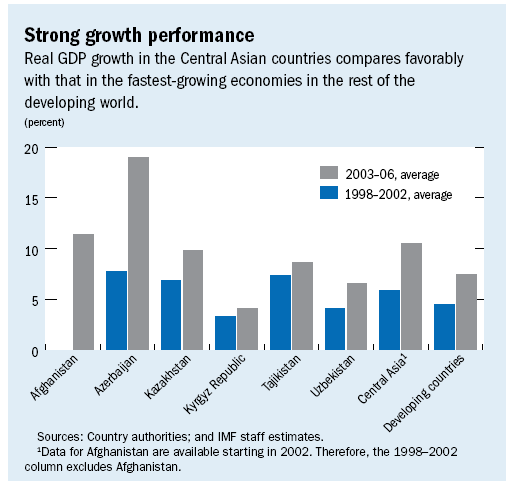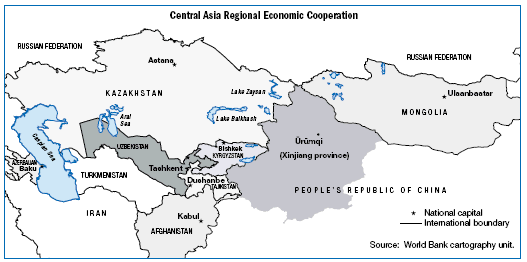
Typical street scene in Santa Ana, El Salvador. (Photo: iStock)
IMF Survey: Boosting Central Asian Economic Cooperation
June 21, 2007
- Maintaining growth, further reducing poverty are region's top priorities
- Region hampered by landlocked setting, underdeveloped transport links
- Determined efforts to further regional cooperation are under way
In recent years, Central Asian countries have registered strong growth (see chart), boosting per capita incomes and making a dent in poverty.

Oil field in Xinjiang region of China, which benefits from Central Asia Regional Economic Cooperation program (photo: Frederic Brown/AFP)
Increasingly integrated Eurasia
Maintaining their growth momentum and further reducing poverty are these countries' top priorities. However, it will be difficult for them individually to achieve these goals because the region is hampered by its landlocked setting, underdeveloped transport links, and institutional weaknesses.
These countries are benefiting from the Central Asia Regional Economic Cooperation (CAREC) program, which helps Central Asian and neighboring countries realize their potential in an increasingly integrated Eurasia.
At the same time that their growth has increased, the Central Asian countries have seen generally stronger balance of payments positions, improved public finances, a buildup of official foreign currency reserves, and a decline in their debt-to-GDP ratios. As a result, they have become more resilient to external shocks.
Inflation is generally under control, although inflationary pressures have recently reemerged as a result of large foreign exchange inflows and strong domestic demand. The countries will have to address these pressures by tightening fiscal or monetary policies, or both; increasing exchange rate flexibility; and adopting reforms to enhance productivity and thereby maintain the competitiveness of their economies.
From opportunity to reality
Central Asia—which bridges Europe and East Asia as well as North and South Asia—is richly endowed with oil, gas, copper, gold, uranium, and water for hydropower and is surrounded by some of the most dynamic of the world's economies. These characteristics provide Central Asian countries with the opportunity to emerge as a center for trade, achieve even higher levels of growth, and further reduce poverty.
By joining forces with their neighbors, the countries can harness the opportunity presented by their strategic regional location, rich natural resources, and dynamic neighbors. Turning these opportunities into reality will require, in addition to sound macroeconomic policies, improved connectivity among countries through roads and railways, better management of the region's natural resources, shorter transit times in customs, and open trade regimes, as well as improvements in the investment climate in each country.
Unique partnership
In this context, the CAREC program, initiated in 1997, is unique. It represents a partnership of eight countries and six multilateral institutions. The participating countries, with a combined population of more than 100 million and occupying a land area of about 7.5 million square kilometers, are Afghanistan, Azerbaijan, the People's Republic of China (focusing on Xinjiang Uygur Autonomous Region), Kazakhstan, the Kyrgyz Republic, Mongolia, Tajikistan, and Uzbekistan (see map).
The Russian Federation and Turkmenistan have participated in some CAREC meetings and have standing invitations to join the program. The multilateral partners are the Asian Development Bank, the European Bank for Reconstruction and Development, the IMF, the Islamic Development Bank, the United Nations Development Program, and the World Bank.
The CAREC program is focused on four priority areas: transport, energy, trade facilitation, and trade policy. A coordinating committee consisting of representatives from member countries and multilateral institutions is leading the work in each area.
The Asian Development Bank, which also serves as CAREC's secretariat, coordinates the technical work of the committees for the transport sector and trade facilitation. The World Bank is responsible for the energy sector committee, and the IMF leads the trade policy committee, the only committee that focuses exclusively on policies and not on projects.

The program has various objectives in each of the priority areas:
• In the transport area, the objective is to rehabilitate transport networks, improve connections, and reduce transport costs. To this end, the multilateral partners have funded such projects as the Almaty-Bishkek regional road rehabilitation, the southern transport corridor road rehabilitation, and the regional railways rehabilitation.
• In the energy sector, the aim is to support efficient and rational use of energy and water through cooperation. The program has focused on key investment projects, such as the regional power transmission interconnection and power rehabilitation projects.
• In trade facilitation, the work is focused on modernizing customs and increasing cooperation among countries through the use of information technology to automate customs services and data exchanges, joint customs control and single window practices, and regional transit development. In this regard, the reform and modernization of customs in the Kyrgyz Republic and Tajikistan is an important project.

• In the trade policy area, the objective is to help member countries adopt more open trade regimes, including through membership in the World Trade Organization, and to coordinate their trade policies to facilitate intraregional and international trade. To this end, the work has focused on preparing a series of papers on barriers to trade and regional trade arrangements in Central Asia, with policy recommendations to be adopted by governments.
In addition, outreach activities and training seminars on trade policy issues for member countries are important aspects of the committee's work. So far, the trade policy committee has made concrete policy recommendations to reduce barriers to transit trade and reform trade taxes in CAREC countries.
Ministers from the CAREC member countries have endorsed the recommendations, and the implementation of the measures is being monitored. The committee is undertaking analytical work related to border trade and quantitative restrictions to trade in CAREC member countries, with a view to making concrete policy recommendations on both issues during the coming year.
Moving in right direction
In October 2006, at CAREC's fifth ministerial conference, the ministers endorsed a comprehensive action plan for the medium to long term that would be based on a resultsoriented program and require strong country ownership and accountability. As part of this action plan, each of the four committees will be developing medium-term sector strategies over the coming year. These strategies will incorporate the priorities identified by CAREC member countries on the basis of the region's needs for integration and will set out the outcomes in a results-based format.
Sound macroeconomic policies at the country level combined with successful regional integration and cooperation are essential to achieving higher growth and reducing poverty in Central Asia. It is encouraging that economic policies are moving in the right direction and that determined efforts to further regional cooperation are under way.
With the continuation of these policies and with support from the international community, all countries in the region will be in a better position to exploit their considerable economic potential and meet the legitimate aspirations of their growing populations.







